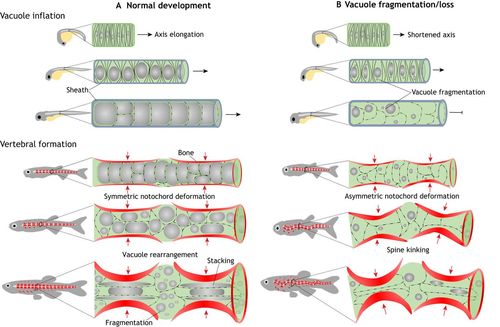Fig. 2
- ID
- ZDB-FIG-201029-6
- Publication
- Bagnat et al., 2020 - Development of a straight vertebrate body axis
- Other Figures
- All Figure Page
- Back to All Figure Page
|
Role of notochord vacuolated cells in axis elongation and spine formation. (A) During normal development, as vacuolated cells nucleate and inflate their large fluid filled vacuole (gray spheres) in an anterior-to-posterior direction within the semi-rigid sheath they generate hydrostatic pressure that pushes axis elongation. Later in development, vertebral bone (red) is deposited around the notochord in a segmented fashion, creating an alternating pattern of vertebral and intervertebral domains. As the vertebrae grow concentrically, the large vacuoles are able to absorb the compressive force, allowing symmetrical bone growth. During this period, some vacuolated cells are stacked under the growing bone, whereas in other cells, vacuoles fragment and the cells localize to the IVD domains. This process allows for symmetric bone growth, IVD formation and a straight spine formation. (B) When vacuoles fragment prematurely or are lost, internal notochord pressure is lost, leading to shortening of the embryonic axis. Vacuole loss also causes the notochord to lose its ability to absorb the force of the growing vertebrae evenly and locally. As vertebral bone grows the notochord is deformed asymmetrically, causing vertebral malformation and kinking of the spine axis. |

